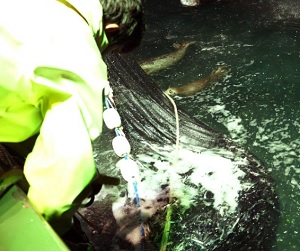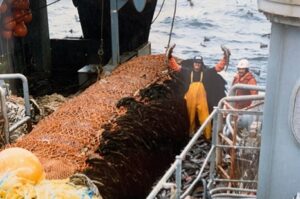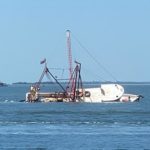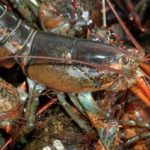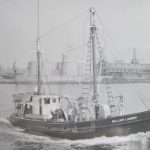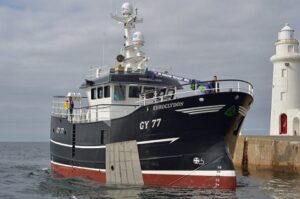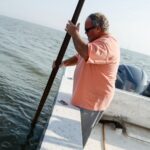Tag Archives: sea lions
In the Pacific Northwest, killing sea lions is a necessity
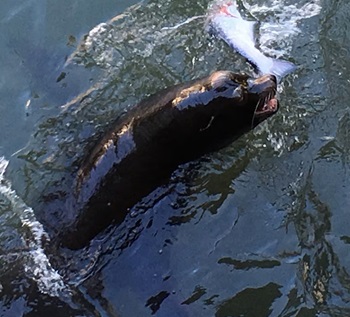 Don’t let their adorable faces and playful personalities fool you: California and Steller sea lions are capable of having disastrous impacts on nonnative ecosystems. In places like the Columbia River Gorge, these so-called dogs of the sea have been encroaching on native fish habitats for decades. Making homes in the Pacific, in coastal areas like the beaches of California, Alaska and Japan, these sea lions especially thrive on the West Coast, where population numbers are estimated to have grown from 75,000 to 257,000 in the last 30 years. This population boom has meant increased nutritional needs, sending thousands of sea lions inland in search of prey. One of the easiest targets for sea lions is the Columbia River, one of North America’s largest rivers and a key migration route for North American fish. The picturesque river valley abounds with seafood, including 13 federally protected species. more, >>CLICK TO READ<< 10:12
Don’t let their adorable faces and playful personalities fool you: California and Steller sea lions are capable of having disastrous impacts on nonnative ecosystems. In places like the Columbia River Gorge, these so-called dogs of the sea have been encroaching on native fish habitats for decades. Making homes in the Pacific, in coastal areas like the beaches of California, Alaska and Japan, these sea lions especially thrive on the West Coast, where population numbers are estimated to have grown from 75,000 to 257,000 in the last 30 years. This population boom has meant increased nutritional needs, sending thousands of sea lions inland in search of prey. One of the easiest targets for sea lions is the Columbia River, one of North America’s largest rivers and a key migration route for North American fish. The picturesque river valley abounds with seafood, including 13 federally protected species. more, >>CLICK TO READ<< 10:12
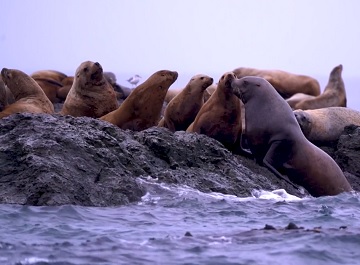
Sea lions, seals might be hampering WA salmon recovery. What can be done?
State officials are now exploring whether to kill sea lions and seals in the Salish Sea and outer coast in a desperate effort to save salmon species from extinction. A new report commissioned by the state Legislature and completed by the Washington Academy of the Sciences says seals and sea lions are likely impeding salmon recovery, and the full impacts of predation on salmon may not be fully understood without lethal intervention. Three mammals specifically have skyrocketed. From 1975 to 2015, the harbor seal population in the Salish Sea exploded from about 6,000 to around 50,000. And California sea lions rose from 50,000 to somewhere around 300,000 on the West Coast of the U.S., according to the Northwest Indian Fisheries Commission. Populations of Steller’s sea lions living around Washington, Oregon and California steadily rose from an estimated 15,000 in 1982 to more than 43,000 in 2019. >click to read< 09:14
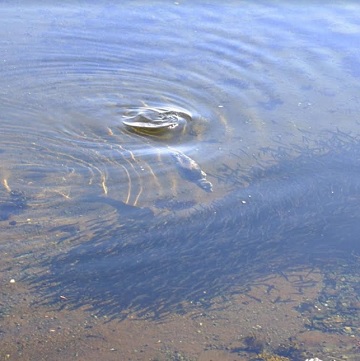
Make-or-break moment for province’s Liberal MPs; seal vote goes before Parliament on Wednesday
Seaward Enterprises Association of Newfoundland and Labrador (SEA-NL) is calling on the province’s six Liberal Members of Parliament to vote for a bill before Parliament Wednesday (July 15th) that would force Fisheries and Oceans to implement seal management plans. “This is one of those make-or-break moments for our Members of Parliament when they must decide whether they represent Newfoundland and Labrador in Ottawa or the other way around,” says Ryan Cleary, Executive Director of SEA-NL, and a former NDP MP. “Seals eat fish just as surely as MPs need votes.” Bill C-251 calls on the federal minister of Fisheries and Oceans to develop management plans for pinnipeds — including seals, sea lions, and walruses on the East and West coasts and Northern Canada. >click to read< 09:00
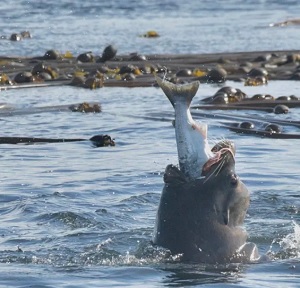
Are sea lions and seals eating too much of B.C.’s salmon? The answer may lead to a cull
An increasing number of the protected seals and sea lions (larger than seals, sea lions can walk) may be upsetting the balance of the British Columbia marine ecosystem. Now some First Nations are proposing a cull. “Environmentalists trying to stop traditional seal and sea lion hunts … are trying to starve out the Indians,” says Tom Sewid of the Kwakwak’wakw First Nation on northeastern Vancouver Island. “I won’t put up with it.” And as seals and sea lions have prospered, salmon have struggled. “The demise of the salmon runs in British Columbia is equivalent if not greater than the extinction of the great buffalo herds across the Great Plains” in the 1800s, says Sewid. > click to read < 09:01

Federal Funding for Killing Sea Lions Might Help Cowlitz River Salmon
Though the actions taken to secure $892,000 in federal funding for the protection of Columbia River system salmon took place thousands of miles from Lewis County, the process could have positive impacts for fishermen of the Upper Cowlitz River and the Columbia basin as a whole. As a result of a joint effort between U.S. Representatives Jaime Herrera Beutler, R-Battle Ground, and Kurt Schrader, a Democrat from Oregon, the appropriations bill passed by congress will include funds to continue the Washington Department of Fish and Wildlife’s (WDFW) efforts to kill sea lions on the Columbia River, protecting salmon and steelhead. Sea lion extermination has been shown to be effective in protecting fish. >click to read< 11:35
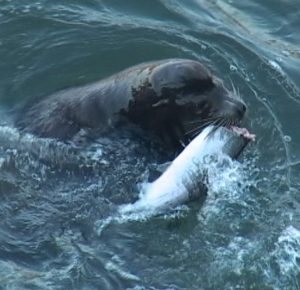
Salmon runs: Remove sea lions
Breaching the Snake River dams will not guarantee an improved salmon run. A better suggestion might be to remove the sea lions from the Columbia River and severely restrict fishing as our Canadian neighbors are doing for their Fraser River run. It is difficult for more salmon to get upstream when they are being overfished, and each sea lion consumes 15 to 40 pounds of fish per day. By John Crawford >click to read< 09:21
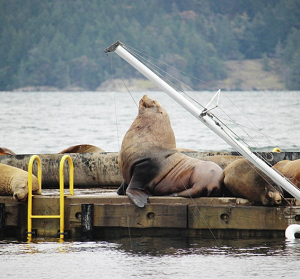
Sea lions throw a party on Cowichan Bay’s federal breakwater to feast on spawning salmon
Steller and California sea lions jostle for space, bark 24-7, and leave stinky feces on the breakwater. About 300 sea lions will climb onto the 182-metre-long concrete dock at one time during at the height of the season, said federal harbour manager Mark Mercer. “They are three layers deep out there.” The majority are males, he said, likening the event to a big bachelor party. Depending on species, males range from about 850 to 2,500 pounds. “Like I tell people: ‘What you see on the breakwater is literally the tip of the iceberg. That’s a tenth of what’s out there.’ >click to read< 12:29

Sea lions take big bite out of early salmon runs
Early runs of wild spring Chinook salmon returning to the Columbia River are bearing the brunt of sea lion attacks, a new study suggests. The fish arrive in early spring before sea lions have left for summer breeding grounds and when the pinniped population is especially high at the river’s mouth. These salmon see higher mortality rates compared to later runs and the numbers have started to climb even over prior years, corresponding with a growing number of sea lions recorded near Astoria. >click to read< 08:56
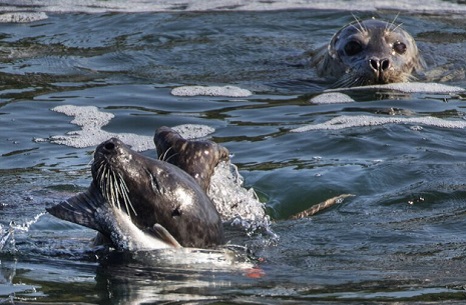
New “Gadget”? Underwater noisemaker to scare away seals at Ballard Locks
On a recent morning, after some acrobatics and horsing around, a seal cruising the locks suddenly took an all-business turn. When it resurfaced, it was with a mouth crammed full of coho. The Hiram Chittenden Locks, built more than 100 years ago, allow navigable access from the freshwater of Lake Washington and Lake Union to Puget Sound. But the locks also inadvertently created an attraction for seals. The concrete chute of the locks concentrates salmon, making easy pickings. As salmon runs have declined in Puget Sound, a range of methods has been tried over the years to shut down the buffet. Underwater firecrackers, pingers, even Fake Willy, a faux orca that used to be lowered into the channel in an attempt to scare off seals and sea lions. Now a new gadget is being tested at the locks, intended to startle seals to deter them. >click to leave< 20:20
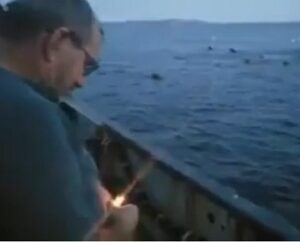
Commercial skipper fined for throwing bear banger at sea lions
B.C. harvester Allan Marsden pleaded guilty in Courtenay Provincial Court to disturbing marine mammals under section 7.1(b) of the Marine Mammal Regulations. Marsden was fined $8,000 and prohibited from possessing explosives for the next three years. The March 2019 incident in the Strait of Georgia made headlines after a video of it surfaced on social media. The video prompted a lengthy investigation by fishery officers from the Georgia Basin North Conservation and Protection detachment out of Nanaimo. (I watched it again, and yes guys. it was awesome!) >video, click to read< 16:48
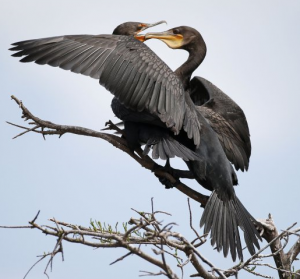
Environmentalists are dragging us back to the Dark Ages
In the early 1990s, our small group of Potlatch employees in cooperation with members of the Lewiston and Clarkston chambers of commerce were researching environmental claims that the lower Snake River dams were devastating salmon runs, when we learned about East Sand Island, a man-made island in the estuary of the Columbia River. The island was formed from dredging deposits in 1983 and by 1984, Caspian terns, cormorants and gulls had colonized the island and were feasting on salmon smolts. We thought: “Wow, this is an easy fix. Tear out a man-made island and save millions of endangered fish.” The environmentalists beat us to the punch. They filed in federal court to protect the island and the birds under the Migratory Bird Treaty Act of 1918. Now we have the largest nesting colony of these non-endangered birds in the world on a man-made island. by Marvin Dugger >click to read< 09:50
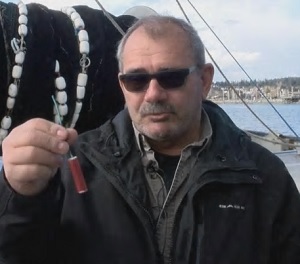
B.C. Herring fisherman charged with tossing a ‘bear banger’ to disperse group of sea lions last year
Herring fisherman Allen Marsden is facing three counts under the Fisheries Act and Explosives Act for tossing a small, explosive device known as a “bear banger” from his boat toward the crowd of animals on March 4, 2019. Fishers and Oceans Canada (DFO) confirmed the charges Wednesday but declined to comment further.,,, “We’re not out there trying to kill the sea lions. We’re not out there looking for sea lions. We’d rather if they weren’t here,” said Marsden. Marsden added the explosive was needed to ensure the safety of fishermen. He said he’d personally been bitten in the past. Video, (I cheered!) >click to read< 17:50
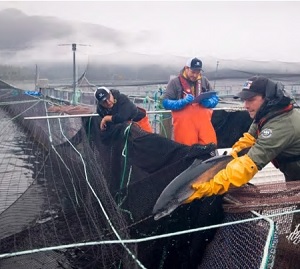
Fish farm owners say most salmon that escaped due to fish farm fire likely eaten by sea lions-Critics want farms phased out
Mowi Canada West downplayed threats to wild salmon stocks because of the number of sea lions feeding on the 21,000 non-native salmon held in pens there, CoastAlaska reported Thursday. Mowi Canada West’s fish farm off Robertson Island, north of Vancouver Island, caught fire Dec. 20. The fire has prompted critics of the industry to call for an end to this kind of farm fishing on the west coast. Phasing out net-pen fish farming in B.C. waters was a Liberal campaign promise in this year’s federal election. >click to read< 13:51

Salmon and steelhead Band-Aids
Here we go again putting a Band-Aid over a sucking chest wound. Ask anyone who spends time on Washington and Idaho salmon and steelhead waters why the salmon and steelhead are declining and you will get a variation of answers. They will range from sea lions to dams to nets to birds to commercial fishing. by Kelly M. Colliton, >click to read< 09:43
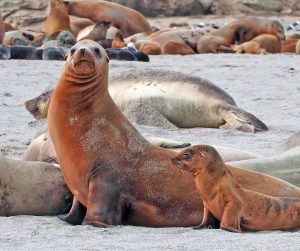
Cull! Plan Mulls Killing More Sea Lions to Save Salmon
Decades of efforts, including billions of dollars spent, to prevent the extinction of 13 species of Columbia River salmon and steelhead were stymied by the resurgence of gregarious mammals who themselves returned from the brink. Now, a new plan backed by Native American tribes and three states would attempt to protect the fish by killing more sea lions. >click to read< 08:54
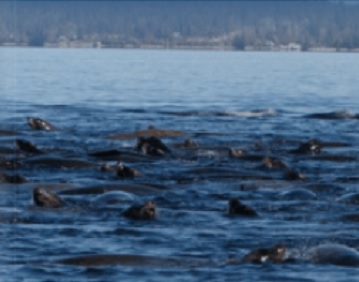
Sea Lions, Other Marine Mammals Discovering South Sound Anchovy Boom
A large suite of marine mammals has discovered Deep South Sound’s new bounty of anchovies, schools of which are now so numerous they’re routinely observed during regular aerial surveys. For three months this past winter, WDFW biologist Steve Jeffries observed hundreds of California sea lions, as well as harbor seals, harbor porpoises and long-beaked common dolphins feeding on a massive pod of the skinny, silvery baitfish in Case Inlet north of Olympia. Anchovy populations have boomed in these waters since 2015 and the Blob’s warm waters. What’s more, the pinnipeds and cetaceans appeared to be teaming up on them. >click to read<20:01
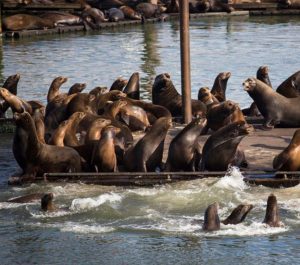
Protected sea lions causing trouble at Northwest ports
A big rebound in the sea lion population along the West Coast in recent years has created a constant battle to wrangle the protected animals. They’re smart and fun to watch from a safe distance, but also noisy, smelly and proving to be a headache for some coastal marinas. “It’s a free zoo kind of, just don’t pet ‘em!” observed Dennis Craig of Olympia,,, The flip side of these flippered fish fiends can be seen in the mounting bill to the marina, including the cost of busted docks, broken electric stanchions and lost business. >click to read<09:05
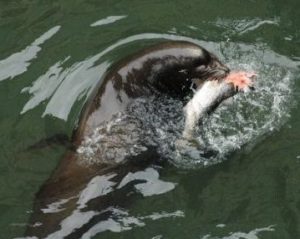
Salmon-eating sea lions targeted at Columbia River dam
More California sea lions preying on imperiled salmon in the Columbia River below a hydroelectric project on the Oregon-Washington border are being killed under a revised policy, federal authorities said Friday. The National Marine Fisheries Service made public reduced criteria for removing sea lions at Bonneville Dam about 145 miles (235 kilometers) from the Pacific Ocean. The new guidelines that went into effect April 17 permit any California sea lion seen in the area on five occasions or seen eating a fish to be put on a list for lethal removal. >click to read<10:57
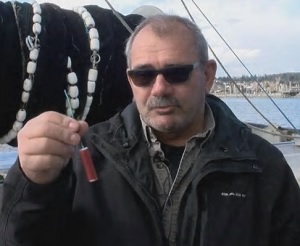
BC Fisherman touches off a “firecracker”, Media blows it’s mind!
Federal fishery officials are investigating after a video was posted to Facebook featuring a man throwing a small explosive toward a group of sea lions in the Strait of Georgia. The clip displays commercial fisherman, Allan Marsden lighting the fuse of a ‘bear banger’ — a small explosive device used to scare bears or other animals — before tossing it into the water. Marsden says he used the bear banger to disperse the sea lions — not to kill them. (If you want to see killing, look at the comments at the article. They’re killing me! lol! ) >Video, click to read<14:09
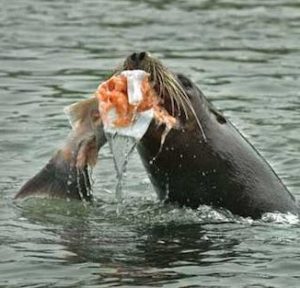
Pressure mounts for a seal harvest in B.C.
Pressure is mounting for a commercial seal harvest in British Columbia after the United States announced it will allow the killing of up to 920 sea lions a year in the Pacific North West to protect endangered wild fish stocks. The American lethal removal program, passed by Congress and signed into law by President Donald Trump last month, for the first time allows American native tribes to kill sea lions that are threatening endangered salmon and steelhead runs to extinction. Government authorities in Washington, Oregon, and Idaho are already allowed to lethally ,,, >click to read<

Oregon starts killing fish-eating sea lions
Oregon wildlife officials have started killing California sea lions that threaten a fragile and unique type of trout in the Willamette River, a body of water that’s miles inland from the coastal areas where the massive carnivorous aquatic mammals usually congregate to feed. The state Department of Fish and Wildlife obtained a federal permit in November to kill up to 93 California sea lions annually below Willamette Falls south of Portland to protect the winter run of the fish that begin life as rainbow trout but become steelhead when they travel to the ocean. >click to read<15:57
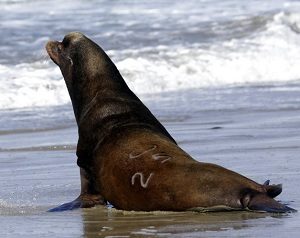
Senate Bill 3119 – Senate passes bill making it easier to kill sea lions
A bill that would make it easier to kill sea lions that feast on imperiled salmon in the Columbia River has cleared the U.S. Senate. State wildlife managers say rebounding numbers of sea lions are eating more salmon than ever and their appetites are undermining billions of dollars of investments to restore endangered fish runs. Senate Bill 3119, which passed Thursday by unanimous consent, would streamline the process for Washington, Idaho, Oregon and several Pacific Northwest Native American tribes to capture and euthanize potentially hundreds of sea lions found in the river east of Portland, Oregon. >click to read<09:17
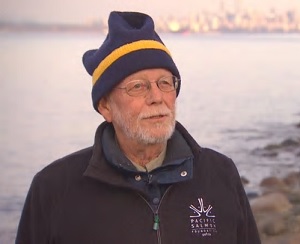
‘Get the balance back’: Amid seal and sea lion boom, group calls for hunt on B.C. coast
For the first time in decades, a small-scale seal hunt is taking place on Canada’s West Coast — all in the hopes that it leads to the establishment of a commercial industry to help control booming seal and sea lion populations and protect the region’s fish stocks.,,, The hunting of seals and sea lions — which are collectively known as pinnipeds — has been banned on the West Coast for more than 40 years. It’s one reason their numbers have exploded along the entire Pacific coastline of North America.,,, Fisheries scientist Carl Walters, a professor emeritus with UBC, believes culling the regions sea lions and seals could dramatically boost salmon stocks. He points to numerous studies showing how pinniped populations have been increasing, while salmon numbers have been plummeting. >click to read<17:14

NMFS approves plan for state officials to kill sea lions at Willamette Falls
Protected under the Marine Mammal Protection Act, the state needed federal approval to take lethal action against the pinnipeds, which have been observed gorging themselves on endangered fish at the foot of the iconic waterfall. “This is good news for the native runs of salmon and steelhead in the Willamette River,” said Shaun Clements, a policy analyst for the state on the sea lion issue. “Before this decision, the state’s hands were tied as far as limiting sea lion predation on the Willamette River.” >click to read<22:52
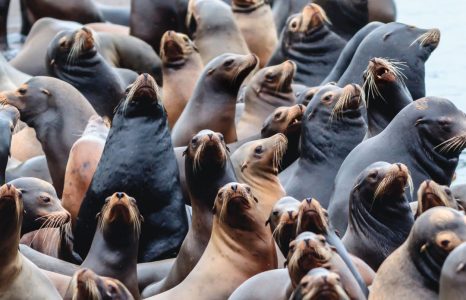
Should Oregon Kill Sea Lions to Save the Salmon?
Used to be, they’d show up at Willamette Falls around late November—beefy males here to bulk up and loll on the docks. Call it sea lion winter break; time off from California’s Channel Islands rookeries, beaucoup steelhead to eat, zero problems. (No pups, no ladies, no predators.) When it was time to head back south, a 400-pound sea lion might have doubled in size, having chowed down on, at minimum, three 15-pound Pacific Northwest salmonids a day. >click to read<19:47
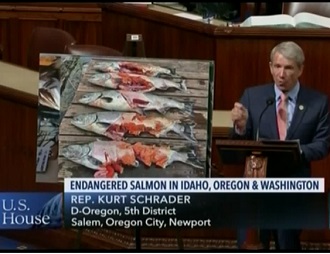
The clock is ticking,,, Endangered Salmon Prevention Act to remove problem sea lions faces time crunch
A bill making its way through the U.S. Senate would allow the states and tribal interests to remove problem sea lions in the Columbia River, including by lethal force, to reduce predation on endangered salmon and steelhead. However, the timeline for the passage of this legislation is growing very short.,, The bill was passed out of committee last week and will be addressed by the full senate soon, but there is a time constraint. If the bill is not passed before Congress adjourns for the year, its future is uncertain. SB 3119 represents the best effort to date to amend the MMPA since its inception to allow stronger management of problem sea lions. It specifically targets animals that take up positions at pinch-points where salmon are forced to concentrate and are easy prey for the pinnipeds. >click to read<10:36

Congress must choose threatened salmon over sea lions
State, federal and local governments have spent too much time and money restoring fish runs in the Columbia River Basin to let those efforts go to waste. The U.S. House recognized this reality last month by passing legislation to make it easier to kill sea lions that feast on threatened salmon and steelhead in the Columbia River and its tributaries. Now, the Senate must step up and push the bill through to the finish line. Northwest senators must be unified in their support for this common-sense measure, which aims to safeguard the billions of dollars invested in preserving fish that are listed under the Endangered Species Act.>click to read<

Sympathy to new state Washington Department of Fish and Wildlife director
Dear Mr. Kelly Susewind, Allow me to express my deepest sympathy. .,, You said it was an honor to serve the people of the state of Washington. And you want to “deliver the results they deserve.” That’s scary.,, The orcas are starving from a lack of salmon. So, we shut down the salmon hatcheries and protect the exploding population of sea lions, seals, cormorants and mergansers that eat as many salmon as the orca and humans put together. The surviving salmon are forced to swim through the thousands of tons of pollutants in a chemical stew that we dump into Puget Sound every year, whose ingredients include but are not limited to sewage, drugs, pesticides, herbicides, personal care products and industrial chemicals, while ignoring the impacts on fish, orcas and humans. Pat Neal >click to read<14:59
Washington Department of Fish and Wildlife names Kelly Susewind new director – >click to read<

In their battle against sea lions, fish are losing – Support The Endangered Salmon and Fisheries Predation Protection Act
The tally doesn’t look good for steelhead and salmon on the Columbia River. Last year, sea lions devoured an estimated 9 percent of steelhead and 5 percent of spring chinook trying to make their way upstream past Bonneville Dam. Even more disconcerting, an estimated 24 percent of chinook disappeared between the mouth of the Columbia and the dam. In other words, there is a battle going on in the Columbia, and the sea lions are winning. That points out the need for Congress to pass a bill sponsored by Rep. Jaime Herrera Beutler, R-Battle Ground. >click to read<12:53






